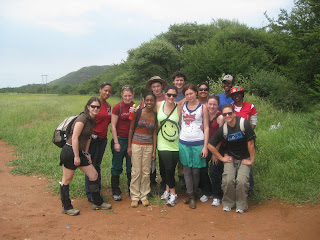This past weekend Ani and I went to Riverwalk for some much needed shopping and to see Sherlock Holmes (again). The movie theater there is nice, but it was a somewhat odd experience to watch this film surrounded by a group of kids up from South Africa while a thunderstorm raged audibly outside. These thunderstorms are much more frequent than I expected, but they are a welcome reprieve from the heat. And in Botswana, when it rains it pours.

My attempt to capture the rain on film

Thank goodness for the gutters that line all the paths on UB’s campus
Then Sunday I went with myself and one other CIEE girl went to watch our fellow CIEE participant Allie play with the UB women’s soccer team. Although Allie couldn’t play due to some issues on the school’s part of completed paperwork, it was interesting to watch the team. The field is dirt (this is pretty typical for the soccer fields around here) and the boundaries are drawn ahead of time. I have absolutely no idea what they do when it rains. Our team lost, but apparently the team they were playing (Township Rollers) is pretty good, so I will suspend any assessment of their skill until I’ve seen more games – that was Kaija Bergen, your weekly sports reviewer J

Girls playing sports

Dudes watching the game under a tree get the front row seats
Today in addition to classes (more on those in a bit) Batsi got the former Minister of Health to come and speak to the CIEE kids about the AIDs epidemic in Botswana, which was wonderful! The focus was the socio-cultural factors that contribute to the spread of the virus, as well as a basic review of what the government has been doing to stop it. It may interest some to know that health care in Botswana is free J This evening, we went to a UB writer’s workshop where anywhere from 50 to 70 of us crammed into a very hot room to listen to students recite (mostly) poetry. Having sat through a number of poetry gigs at Mac, it was fun to listen to what these students were writing. There’s much more of a rap/hip hop feel to a lot of what’s being done here, as well as more incorporation of music.

Poetry ‘round the world
I was told that school here at the University of Botswana would be a change from Macalester, and thus far that has certainly proven itself to be true. Quite apart from the fact that I am not currently slogging through snow and that internet continues to remain an elusive commodity, there are various changes in just how school works. Because UB is several thousand students larger than Macalester, I was prepared for much larger classes and (foolishly) a degree of anonymity.
My literature classes were surprisingly not larger than a Mac class and even the Poli Sci classes are not huge. I think this is in part due to the fact that attendance at UB isn’t very consistent. The first week I had several students laugh at me when I asked if they had gone to class (the first week isn’t officially a “shop” week, but unofficially everyone recognizes that only about half of the students actually come). But despite the relatively small class size, the lesson doesn’t operate like those to which I’m accustomed. From what I’ve been told, students in Botswana learn under a heavily “teacher-centered” approach that involves a teacher lecturing in front of the class for 50 minutes and perhaps two assignments for the semester. Ironically, this is the college my high school teachers told me to expect. Things are more laid back here, with the understanding that the end of the semester is reserved for cramming.

I’ve yet to see a clock on time here at UB – they are all on Botswana time!
The other “culture-shock” experience with which I am currently dealing is, dramatically J, that of my own “whiteness.” I knew I’d be a minority here in Botswana and I was, if not looking forward to it, at least aware of the learning opportunity this presented. It’s really on-campus (with its forty white students) that I am most aware of my own skin color. Students often stare and guys come to get your number simply because you are foreign. For someone hesitant to engage in conversation with people I don’t know even when I’m in the height of my comfort zone, this has all been a bit disconcerting. I’m frequently possessed by the urge to tell people, “You’ve got it wrong. I’m actually really not that interesting. ” I remind myself that what I’m experiencing here as a minority is what a lot of people live every day. Except that for many people in, say, the United States, it isn’t simply curiosity that fuels peoples’ stares, but hostility and judgment, something I have not felt here at all. So is it a learning experience? Most certainly. Are there days when I just wish I looked like a Motswana? Oh yes.
Outside of classes, Ani and I have had a pretty dead week. If you don’t fill your time here yourself, it will remain empty. The homework load isn’t much to speak of and I never realized just how much time I spent doing that at Mac until it was gone and now I’m suddenly staring at hours of uncharted time. Part of this has been nice. It’s given us the opportunity to adjust, get some time to ourselves, and put a dent in our pleasure reading (oh Harry Potter books how lovely you are J). However, I can see where this would rapidly get old. Ani is working to set up a volunteer position with a local hospital and I’ve asked Batsi to look into something government related for me (as you can see, I have very specific desires).



















































